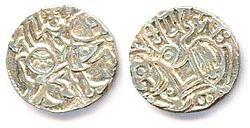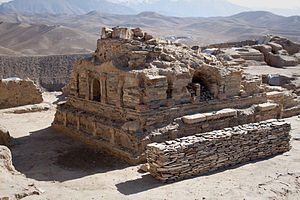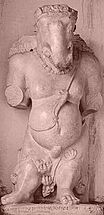The Shahi
(Devanagari: शाही),[2] Sahi,[3] also called Shahiya[4][5] dynasties ruled one of the Middle kingdoms of India which included portions of the Kabulistan and the old province of Gandhara (now in northern Pakistan), from the decline of the Kushan Empire in the 3rd century to the early 9th century.[5] The kingdom was known as “Kabul Shahi” (Kabul-shāhān or Ratbél-shāhān in Persian کابلشاهان یا رتبیل شاهان) between 565 and 879[6] AD when they had Kapisa and Kabul as their capitals, and later as Hindu Shahi.[7]
The Shahis of Kabul/Gandhara are generally divided into the two eras of the so-called Buddhist-Shahis and the so-called Hindu-Shahis, with the change-over thought to have occurred sometime around AD 870.
Hsuen Tsang clearly describes the ruler of Kapisa/Kabul, whom he had personally met, as a devout Buddhist and a Kshatriya and not a Tu-kiue/Tu-kue (Turk). The Chinese pilgrim Xuanzang knew well enough what a Turk was since he had come to Kabul through their country. Against the contemporary evidence of Hsuen Tsang, an absurd tradition related by Alberuni after 400 years and with evident reluctance and disbelief in it cannot, therefore, be taken for history. The confused accounts of 11th-century Persian Muslim scholar Alberuni, (“which bear the impress of folklore for the early history of the Kabul Shahi rulers”)[8] state that:
- the Hindu kings residing in Kabul were Turks
- said to be of Tibetan origin
- that the first of them was a Barahatakin (founder of the dynasty), who came (from Tibet) into the country (Kabul), entered a cave and after a few days, started to creep out of it in the presence of people who looked upon him as a “new born baby”, clothed in Turkish dress. People honoured him as a being of miraculous birth, destined to be a king. And he brought those countries under his sway and ruled under the title of Shahiya of Kabul
- the rule remained among his descendants for about sixty generations, till it was supplanted by a Hindu minister and
- in this series of his descendant rulers, one was Kanik (Kanishaka?) who is said to have built Vihara in Purushapura, which is called Kanika Caitya.[9]
Thus the folklore accounts recorded by Alberuni connect the earlier Shahis of Kabul/Kapisa to Turkish extraction and also claim their descent from Kanik (or Kanishaka of Kushana lineage). At the same time it is also claimed that ‘their first king Barahatigin (Vrahitigin?) had originally come from Tibet and concealed in a narrow cave in Kabul area (and here is given a strange legend which we omit).’ One can easily see the above account of Shahi origin as totally fanciful and fairy tale-like. These statements taken together are very confusing, inconsistent and bear the express marks of a folklore and vulgar tradition, hence unworthy of inspiring any confidence in the early history of Shahis. The allegation that the first dynasty of Kabul was Turki is plainly based on the vulgar tradition, which Alberuni himself remarked was clearly absurd.
Based on Alberuni’s accounts, V. A. Smith speculates that the earlier Shahis were a cadet branch of the Kushanas who ruled both over Kabul and Gandhara until the rise of the Saffarids. H. M. Elliot relates the early Kabul Shahis to the Kators and further connects the Kators with the Kushanas. Charles Frederick Oldham also traces the Kabul Shahi lineage to the Kators—whom he identifies with the Kathas or Takkhas—Naga worshipping collective groups of solar (Sun-worshiping) lineage. He further speaks of the Urasas, Abhisaras, Daradas, Gandharas, Kambojas, et al. as allied tribal groups of the Takkhas belonging to the Sun-worshiping races of the north-west frontier.[10][11] D. B. Pandey traces the affinities of the early Kabul Shahis to the Hunas.
The accounts recorded by Alberuni are indeed confusing, but other numerous accounts prove the Kshatriya Punjabi origins of the Shahi dynasty. Hsuen Tsang clearly describes the ruler of Kapisa/Kabul, whom he had personally met, as a devout Buddhist and a Kshatriya and not a Tu-kiue/Tu-kue (Turk).[12] The fact that Xuanzang (AD 644) specifically describes the ruler of Kapisaas Ksatriya,[13] and that of Zabul at this time being known as Shahi[14] casts serious doubt about the speculated connections of the first Shahis of Kabul/Kapisa to the Kushanas or the Hephthalites. Neither the Kushanas nor the Hunas/Hephthalites nor the Turks (or Turushakas) have ever been designated or classified as Ksatriyas in any ancient Indian tradition. Therefore, the identification of the first line of Shahi kings of Kapisa/Kabul with the Kushanas, Hunas, or Turks obviously seems to be in gross error.[15]
It is very interesting that Alberuni calls the early Shahi rulers Turks, but this should be interpreted to mean Turkised rather than Turkic
The Shahi rulers of Kapisa/Kabul who ruled Afghanistan from the early 4th century till AD 870 were Hindu Kamboj Kshatriyas. The Shahis of Afghanistan were discovered in 1874 to be connected to the Kamboja “race” by E. Vesey Westmacott.[17]
E. Vesey Westmacott,[18] Bishan Singh, K. S. Dardi, et al. connect the Kabul Shahis to the ancient Indian Ksatriya clans of the Kambojas/Gandharas. George Scott Robertson[19] writes that the Kators/Katirs of Kafiristan belong to the well known Siyaposh tribal group of the Kams, Kamoz and Kamtoz tribes.[20] But numerous scholars now also agree that the Siyaposh tribes of Hindukush are the modern representatives of the ancient Iranian cis-Hindukush Kambojas.[21]
The powerful evidence from Hsuen Tsang (AD 644) attesting that the ruler of Kabul/Kapisa was a devout Buddhist and belonged to Ksatriya caste would rather connect this ruling dynasty either to the erstwhile Gandharas or more probably to Ashvaka clan of the Kambojas, the eminentKsatriya clan of the Mauryan times from the neighbouring region in India.[22]
The name (Katorman or Lagaturman) of the last king of the so-called first Shahi line of Kabul/Kapisa simply reveals a trace of Tukhara cultural influence in the Kamboja (Kapisa) region, as hinted in the above discussion. Thus, the first ruling dynasty of Kapisa and Kabul, designated as aKsatriya dynasty by Hsuen Tsang had been a Kamboja dynasty from India
Evidence also exists that some medieval Muslim writers have confused the Kamboja clans of Pamirs/Hindukush with the Turks and invested the former with Turkic ethnicity. For example, 10th-century Arab geographer Al-Muqaddasi, refers to the Kumiji (=Kamoji/Kamboja) tribesmen of Buttaman mountains (Tajikstan),[31] on upper Oxus, and calls them of Turkic race.[32][33][34][35][36] Song Yun, the Chinese Ambassador to the Huna kingdom of Gandhara, in AD 520 writes that the Yethas (Hephthalites) had invaded Gandhara two generations prior to him and had completely destroyed this country. The then Yetha ruler was extremely cruel, vindictive, and anti-Buddhist and had engaged in a three years border war with the king of Ki-pin (Cophene or Kapisa), disputing the boundaries of that country.[37] The Yetha king referred to by Song Yun may have been Mihirakula (AD 515-540/547) or his governor. This evidence also proves that the Kapisa kingdom was well established prior to the Huna/Hephthalite invasion of Gandhara (c. AD 477) and that it did not submit to the Yethas but had survived and continued to maintain its independence.
Once the political clout of the invaders like the Kushanas or the Hephthalites had declined, some native chieftain from the original dominant clans of this region seems to have attained ascendancy in political power and established an independent kingdom on the ruins of the Kushana and/or the Hephthalite empire.
Commenting on the rise of Shahi dynasty in Kabul/Kapisa, Charles Frederick Oldham observes: “Kabulistan must have passed through many vicissitudes during the troublous times which followed the overthrow of the great Persian empire by the Alexander. It no doubt fell for a time under the sway of foreign rulers (Yavanas, Kushanas, Hunas etc). The great mass of the population, however, remained Zoroastrian and Polytheists. And probably too, the Kshatriya chiefs from India retained great shadow of authority, and conquered Kabulistan when the opportunity arose.”.
Barhatigin is said to be the founder of the dynasty which is said to have ruled for 60 generations until AD 870. This, if true, would take Barhatigin and the founding of the early Shahi dynasty back about 20×60=1200 years, i.e., to about the 4th century BC if we take the average generation of 20 years; and to the 7th century BC if an average generation is taken as 25 years. It is well nigh impossible that a single dynasty could have ruled for 1200 (or 1500) years at a stretch. Moreover, King Kanik (if Kanishaka) ruled (AD 78 – 101) not over Kabul but over Purushapura/Gandhara and his descendants could not have ruled for almost 900 years as a single dynasty over Kapisa/Kabul especially in a frontier region called the gateway of India. Pre Islamic Hindu and Buddhist heritage of Afghanistan is well established in the Shahi coinage from Kabul of this period.
Based on fragmentary evidence of coins, there was one king named Vrahitigin (Barhatigin?) who belonged to pre-Christian times as Alberuni’s accounts would tend to establish. If Kanik is same as Kanishaka of Kushana race as is often claimed, then the second claim that the ancestors of the early Shahis came from Tibet becomes incompatible to known facts of history.
According to Olaf Caroe, “the earlier Kabul Shahis in some sense were the inheritors of the Kushana chancery tradition and were staunch Hindus in character.[38] The affinities of the early Shahis of Kapisa/Kabul are still speculative, and the inheritance of the Kushan-Hephthalite chancery tradition and political institutions by Kabul Shahis do not necessarily connect them to the preceding dynasty (i.e. the Kushanas or Hephthalites).
It appears that from start of the 5th century till AD 793-94, the capital of the Kabul Shahis was Kapisa. As early as AD 424, the prince of Kapisa (Ki-pin of the Chinese) was known as Guna Varman.[39] The name ending “Varman” is used after the name of a Ksahriya only.[40][41][42][43] Thus the line of rulers whom Hiuen Tsang refers to in his chronicles appears to be an extension of the Ksatriya dynasty whom this Guna Varman of Ki-pin or Kapisa (AD 424) belonged. Thus this Ksatriya dynasty was already established prior to AD 424 and it was neither a Kushana nor a Hephthalite dynasty by any means.[44]
It appears more than likely that, rather than the Kushanas or Hunas or the Turks, the Shahi rulers of Kabul/Kapisa and Gandhara had a descent[citation needed] from the neighbouring warlike Ksatriya clans of the Kambojas known as Ashvakas (q.v.), who in the 4th century BC, had offered stubborn and decisive resistance to Macedonian invader, Alexander, and later had helped Chandragupta Maurya found the Mauryan empire of India.[45] They were the same bold and warlike people on whom king Asoka Maurya had thought it wise and expedient to bestow autonomous status[46] and to whom he gave eminent place in his Rock Edicts V and XIII. They were fiercely independent warlike people who had never easily yielded to any foreign overlord.[47] They were the people who, in the 5th century AD, had formed the very neighbours of the Bactrian Ephthalites of Oxus and whom Chandragupta II of Gupta dynasty had campaigned against and had obtained tribute from about the start of the 5th century AD.[48][49] Dr V. A. Smith says that this epic verse is reminiscent of the times when the Hunas first came into contact with the Sassanian dynasty of Persia.[50] And the Monghyr grant of king Devapala of the Pala dynasty of Bengal attests that the great king had led his war expedition (AD 810–850) into the northwest against the Hunas (in western Punjab) and then the Kambojas (in the Kabul/Gandhara valleys.[51] Sata-pañcāśaddesa-vibhaga of the medieval era Tantra bookSaktisamgma Tantra[52] locates Kambojas (Kabul Shahis?) to the west of southwest Kashmir (or Pir-pañcāla), to the south of Bactria and to the east of Maha-Mlechcha-desa (=Mohammadan countries i.e Khorasan/Iran) and likewise, locates the Hunas (Zabul Shahis?) to the south of Kama valley (or Jallalabad/Afghnaistan) and to the north of Marudesa (or Rajputana) towards western Punjab.[53]
The Kavyamimasa of Rajshekhar also lists the Sakas, Kekayas, Kambojas, Vanayujas, Bahlikas, Hunas, Pahlvas, Limpakas, Harahuras, Hansmaragas (Hunzas) etc [54] in the north-west. Since Rajshekhar (AD 880–920) was contemporary with Hindu Shahis, he identifies people called Kambojas (Kabul/Kapisa), Vanayujas (Bannus), Limpakas (Lamghanis), Hunas (Zabul), Pahlvas (Persians—Maha-mlechchas), Harahuras (Red Hunas located in Herat) etc almost exactly in the same localities which were occupied by Kabul Shahi and Zabul Shahi kingdoms respectively. The above referred to pieces of evidence again spotlight on the Kambojas and the Hunas together and places them near the environs of the Muslim Persians in north-west. During the 1st century AD and later in the 5th century (c. AD 477), the cis-Hindukush Kambojas and Gandharas partially came under the sway of foreign invaders like the Kushanas and the Hephthalites (Hunas). These warlike people were temporarily overpowered by the numerous hordes but they did not become extinct; and once the political tide of the foreign hordes ebbed, someone from the native chieftains from the original dominant clans (i.e. the Ksatrya Ashvakas) of this region asserted his authority and attained ascendancy in political power and had established himself as Ksatriya overlord of an independent kingdom on the ruins of the erstwhile Kushana and/or the Hephthalites empire.[55] Having been exposed to the foreign environs for a while and having also, in a sense, inherited the Kushana-Hephthalite chancery tradition of their predecessors, these native cis-Hindukush Kamboja/Gandhara rulers had also adopted their political institutions and regal titles such as “shahi” and “tegin” etc in the same way as the Sakas, Kushanas, and Hunas had earlier adopted a form of the Persian Kshathiya/Kshathiya title from their predecessors—the Achamenids of Persia.
The title of “Shahi”
In ancient time, the title Shahi appears to be a quite popular royal title in Afghanistan and the north-western areas of the Indian sub-continent. It was used by Achaemenids[56] Sakas,[57] Kushanas,[58] Hunas,[59] Bactrians,[60] by the rulers of Kapisa/Kabul,[61] and Gilgit.[62] In Persian form, the title appears as Kshathiya, Kshathiya Kshathiyanam, Shao of the Kushanas and the Ssaha of Mihirakula (Huna chief).[63] The Kushanas are stated to have adopted the title Shah-in-shahi (“Shaonano shao”) in imitation of Achaemenid practice.[64]
An ancient Jaina work, Kalakacarya-kathanaka, says that the rulers of the Sakas who had invaded Ujjaini/Malwa in 62 BC also used the titles of Sahi and Sahnusahi.[65] Since the title Shahi was used by the rulers of Kapisa/Kabul or Gandhara also in imitation of Kushana “Shao”, it has been speculated by some writers that the Shahi dynasty of Kapisa/Kabul or Gandhara was a foreign dynasty and had descended from the Kushans or Turks (Turushkas).[5] However, the title has been used by several rulers irrespective of any racial connotations and this may refute the above speculation.
In addition, one ancient inscription and several ancient Buddhist manuscripts from the Gilgit area between upper Indus and river Kabul shed some light on the three kings who ruled in the Gilgit region in the 6th and 7th centuries AD. They also bore Shahi titles and their names are mentioned as Patoladeva alias Navasurendradiyta Nandin, Srideva alias Surendra Vikrmadiyta Nandin and Patoladeva alias Vajraditya Nandin. It is very relevant to mention here that each of the Shahi rulers mentioned in the above list of Gilgit rulers has Nandin as his surname or last name[66] It is more than likely that the surname Nandin refers to their clan name. It is also very remarkable that the modern Kamboj tribe of northern Punjab still has Nandan (Nandin) as one of their important clan names. It is therefore very likely that these Gilgit rulers of upper Indus may also have belonged to the Kamboja lineage.[67][68] Furthermore, “Shahi, Sahi, Shahiya” as a septal name is still carried by a section of the Punjab Kambojs which appears to be a relic from the Shahi title of their Kabul/Kapisa princes.[69]


